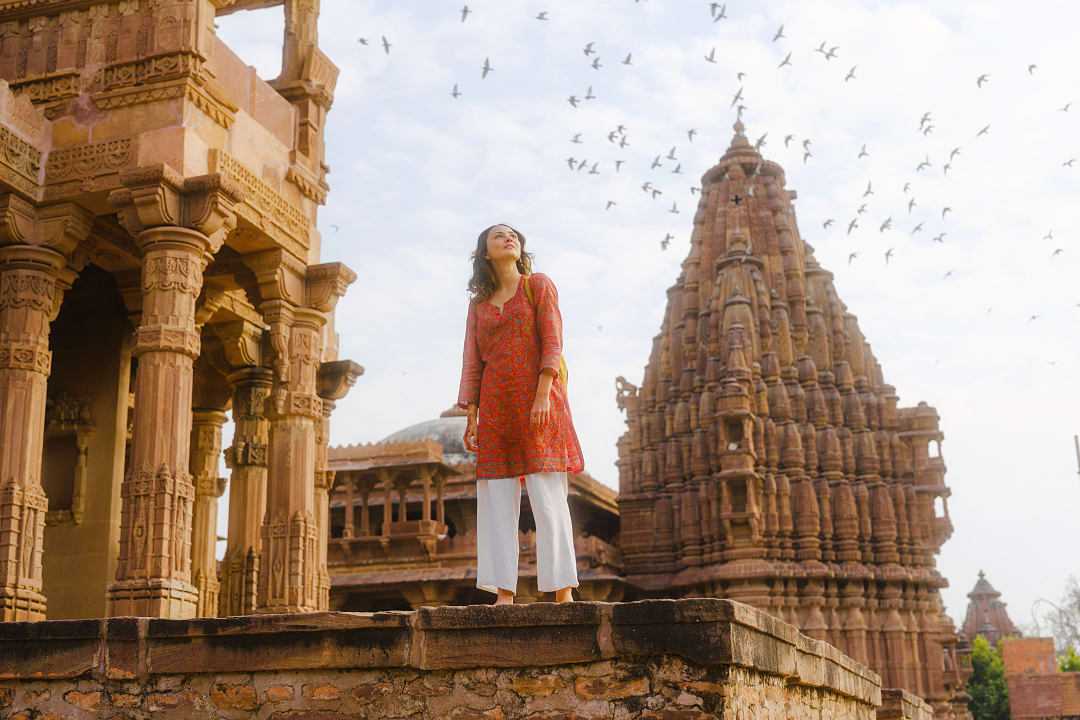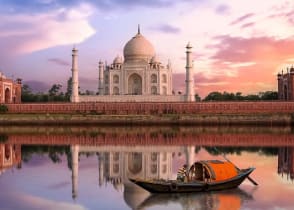India vs Nepal: Where Should I Travel?

Mandore Temple in Rajasthan, India.
India and Nepal are mighty lands whose mysticism captures the imagination of travelers worldwide. Each country offers extraordinary experiences, from ancient temples and breathtaking mountain ranges to deep spirituality.
When choosing between these two mesmerizing destinations, consider your ideal adventure. India draws you in with its vast diversity and rich culture, offering everything from opulent palace stays and vibrant festivals to private tours of ancient temples steeped in history. Meanwhile, Nepal entices travelers with its awe-inspiring Himalayan landscapes, where you can experience luxuries like helicopter tours to Everest Base Camp or serene retreats at world-class wellness resorts amidst nature. Both destinations promise deep spiritual traditions and transformative experiences, but the essence of your journey will depend on whether you’re drawn to India’s dynamic energy or Nepal’s tranquil majesty.
Extraordinary travel begins with a human touch. Our destination specialists design every journey with care, insight, and personal attention. From private cooking classes to guided temple tours, use the following information as a guide to discover India or Nepal before connecting with our travel experts to help you plan your trip.
Where is India?

Nubra Valley in Leh Ladakh, India.
India is a vast subcontinent in South Asia bordered by Pakistan, China, Nepal, Bhutan, Bangladesh, and Myanmar. The country presents an incredible variety of landscapes, from the snow-capped peaks of the Himalayas in the north to the tropical beaches of Kerala in the south. Stand on the edge of the Thar Desert, where golden sands stretch endlessly under a blazing sun, or wander through lush forests and tea plantations in the eastern states, where the air is fragrant with the scent of fresh leaves.
The northern plains are home to historic cities like Delhi, Agra, and Varanasi. Gaze at the majestic Taj Mahal as its white marble shimmers in the sunlight or walk along the ghats of Varanasi as locals perform ancient rituals along the sacred Ganges River. The southern regions offer a different flavor with their Dravidian temple architecture, peaceful backwaters where houseboats glide silently over still waters, and vibrant coastal cities alive with colorful markets and spicy street food like fried potato dumplings in a bun that are called vada pav.
Where is Nepal?

The Himalayas in Nepal.
Nepal is a landlocked country nestled in the Himalayas between India and Tibet. It is home to eight of the world's 10 tallest mountains, including Mount Everest. As you traverse its geography, you'll encounter three distinct regions: the towering Himalayan belt in the north, where jagged peaks pierce the sky; the central hill region dotted with terraced fields; and the southern Terai plains that cradle subtropical jungles.
The cultural nucleus of Nepal centers around the Kathmandu Valley, where ancient cities like Kathmandu, Patan, and Bhaktapur showcase intricate wood carvings and temples adorned with vibrant prayer flags fluttering in the wind. The varied altitude zones create diverse ecosystems. Trek through subtropical jungles teeming with wildlife before ascending into alpine conditions where yaks roam among wildflowers.
What are the Similarities Between India and Nepal?

Couple admiring the Taj Mahal in Agra, India
India and Nepal share deep cultural and religious connections, particularly through Hinduism and Buddhism. Both countries celebrate major festivals like Diwali and Dashain, though local customs add unique flavors to these celebrations. The shared cultural heritage is evident in ornate temples and religious monuments that invite exploration on your luxury tour.
Culinary traditions also connect these destinations. Picture savoring lentil-based dishes paired with warm flatbreads or aromatic curries that fill your senses. In India, indulge in butter chicken, while in Nepal, delight in steaming hot dumplings.
Both countries offer remarkable opportunities for spiritual exploration. Meditate at ancient temples or practice yoga at serene ashrams surrounded by breathtaking landscapes that inspire reflection.
What are the Differences Between India and Nepal?

Spins prayers wheels in the Tibet, Nepal.
India's enormous size and population create a more diverse travel experience filled with dramatic variations in culture, language, and customs from state to state. In contrast, Nepal offers a more concentrated cultural experience centered around its Himalayan identity and strong Buddhist influences.
While both countries have rich festival traditions, India's celebrations tend to be more elaborate and varied, reflecting the diverse religious and cultural makeup you can experience on our immersive India tour. The Holi festival transforms cities and villages into kaleidoscopes of color as revelers douse each other with vibrant powders and water, celebrating spring's arrival with music, dance, and traditional treats. Nepal's festivals often focus more on its unique blend of Hindu and Buddhist traditions, with events like the Kumari Jatra. This celebration focuses on the country’s living goddess tradition, during which a young girl is chosen to be venerated as a living incarnation of the goddess Taleju.
The pace of life and tourism also differs significantly. India's major cities pulse with energy and modernity, while Nepal generally maintains a more relaxed, traditional atmosphere that you can experience on our highlights of Nepal for families itinerary. India's architectural heritage spans multiple dynasties and colonial influences, while Nepal's architectural treasures primarily reflect its medieval kingdoms and religious history.
Does India or Nepal Have Better Temples?

Hoysaleswara Temple in India.
India and Nepal overflow with unique and historical spiritual architecture. India is home to some of the most revered temples, including Varanasi’s Kashi Vishwanath Temple, which is dedicated to Lord Shiva and attracts millions of pilgrims annually. Another notable temple is the Brihadeeswarar Temple in Thanjavur, a UNESCO World Heritage site known for its stunning Dravidian architecture and massive granite structure that exemplifies the artistry of ancient South Indian temple construction.
Nepal boasts temples like the Pashupatinath Temple in Kathmandu, which is also dedicated to Lord Shiva. The UNESCO World Heritage Site is one of the holiest Hindu temples globally, attracting devotees from around the world. The complex features numerous smaller temples and shrines, showcasing intricate Newari architectural styles. The country’s Lumbini site features the Maya Devi Temple, which showcases a blend of Buddhist architecture from various countries.
The choice between India and Nepal for temple visits depends on your personal preferences regarding spiritual significance and architectural styles. While India's temples often highlight grand scale and historical depth, Nepal's offerings are deeply intertwined with Hindu and Buddhist traditions, providing a serene atmosphere that reflects its cultural heritage. Each destination presents an opportunity to explore profound spiritual experiences through sacred sites.
Does India or Nepal Have Better Mountains?

Annapurna mountains in Nepal.
India boasts impressive Himalayan regions in states like Uttarakhand and Himachal Pradesh. However, Nepal is undeniably the premier destination for mountain experiences. Trek through Nepal's breathtaking landscapes, where eight of the world's highest peaks rise majestically above you. The trekking infrastructure is well-developed, ensuring you access to some of nature's most awe-inspiring vistas.
India's mountain regions offer unique experiences like the Buddhist culture of Ladakh and the tea plantations of Darjeeling, but Nepal's entire identity is built around its mountains, with better-established trekking routes, mountain tourism facilities, and a more comprehensive range of hiking options that you can expect on our two-week Tour of Nepal.
What Are the Top Activities in India?

Ganges River in Varanasi, India.
Explore iconic sites like the Taj Mahal. Immerse yourself in spiritual experiences along the Ganges River in Varanasi. Witness the elaborate Ganga Aarti ceremony each evening at Dasaswamedh Ghat as flaming brass lamps illuminate faces filled with devotion. Experience luxury train journeys across Rajasthan while staying in converted palaces steeped in royal history.
Venture into national parks such as Ranthambore or Bandhavgarh for thrilling tiger spotting or relax on Goa's pristine beaches, where Portuguese colonial heritage meets vibrant nightlife. Participate in cooking classes to master regional cuisines or shop in bustling markets for textiles that showcase India's artistic traditions.
What Are the Top Activities in Nepal?

Base Camp circuit in the Everest in Nepal.
Trek legendary routes like the Annapurna Circuit or Everest Base Camp. Feel your heart race as you navigate trails surrounded by towering peaks while immersing yourself in local culture on the ultimate tour of the Everest region. Explore medieval cities within Kathmandu Valley, where ancient temples stand sentinel over bustling markets filled with traditional crafts like metalwork and pottery.
Practice meditation or yoga at spiritual centers offering stunning views of snow-capped mountains that evoke tranquility. Go on wildlife safaris in Chitwan National Park to spot rhinos grazing peacefully or try adventure sports like paragliding over Pokhara’s shimmering lakes framed by majestic hills.
Visit traditional villages to learn about local customs like Dashain Tika, when younger family members receive blessings from their elders amidst joyous celebrations, or partake in Buddhist ceremonies at ancient monasteries echoing centuries of devotion.
Is it Easier to Travel to India or Nepal from the US?

New Delhi, India.
Major US cities offer direct flights to Delhi and Mumbai in India. In contrast, traveling to Nepal typically requires at least one connection through Middle Eastern or Asian hubs, making India more accessible for direct travel from the US.
Choose India For:

Jama masjid Mosque in Delhi, India.
- Incredible diversity in landscapes, cultures, and experiences
- Iconic monuments like the Taj Mahal and ancient temples
- Rich artistic heritage through music, dance, and crafts
- Varied regional cuisines and culinary traditions
- Luxury travel experiences in palace hotels
- Wildlife safaris and biodiversity
- Colonial architecture and historical sites
- Shopping for traditional crafts and textiles
India offers everything from desert palace hotels to tropical backwaters, ancient temples to colonial architecture, and traditional performances to wildlife encounters. The country's size and diversity ensure you can find your perfect adventure, whether spiritual, cultural, or natural. For more inspiration, see our India tours and vacations.
Choose Nepal For:

- World’s best mountain trekking and hiking experiences
- Intimate cultural encounters in traditional villages
- Advanced Buddhism and meditation practices
- Adventure sports set against spectacular backdrops
- Compact size allowing easier travel planning
- Rich Himalayan ecosystems teeming with wildlife
- Traditional arts and craft traditions
- Peaceful atmosphere fostering spiritual focus
Nepal's concentrated blend of natural wonders and cultural treasures creates an ideal destination if you are seeking mountain adventures and spiritual connections. The country's smaller size and focused identity make it perfect for combining outdoor activities with cultural immersion in a manageable geographic area. Find out more by taking a look at our Nepal vacations and tours.
Discover More About India and Nepal

Walls of Amber in Jaipur, India.
Whether you choose India's vast diversity or Nepal's mountainous majesty, both destinations offer transformative travel experiences that linger long after your journey ends. Your choice might depend on whether you prefer India's kaleidoscope of cultures or Nepal's focused combination of mountain adventures intertwined with spiritual traditions.
Our travel experts specialize in crafting journeys that capture the essence of these remarkable destinations. For more inspiration on traveling through India or discovering the wonders of Nepal, explore our detailed India travel guide or take a look at our Spirituality and Adventure: Iconic One-Week Nepal Tour for information on the experiences that await you in the country.
Life-Enriching Travel Designed Just for You
- 1
Trips curated by the world’s top destination experts
- 2
Concierge-level service leading up to and during your trip
- 3
Unique, exclusive experiences and insider access





